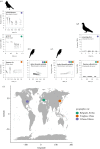What's the rumpus? Resident temperate forest birds approach an unfamiliar neotropical alarm call across three continents
- PMID: 37788715
- PMCID: PMC10547545
- DOI: 10.1098/rsbl.2023.0332
What's the rumpus? Resident temperate forest birds approach an unfamiliar neotropical alarm call across three continents
Abstract
Alarm signals have evolved to communicate pertinent threats to conspecifics, but heterospecifics may also use alarm calls to obtain social information. In birds, mixed-species flocks are often structured around focal sentinel species, which produce reliable alarm calls that inform eavesdropping heterospecifics about predation risk. Prior research has shown that Neotropical species innately recognize the alarm calls of a Nearctic sentinel species, but it remains unclear how generalizable or consistent such innate signal recognition of alarm-calling species is. We tested for the responses to the alarm calls of a Neotropical sentinel forest bird species, the dusky-throated antshrike (Thamnomanes ardesiacus), by naive resident temperate forest birds across three continents during the winter season. At all three sites, we found that approaches to the Neotropical antshrike alarm calls were similarly frequent to the alarm calls of a local parid sentinel species (positive control), while approaches to the antshrike's songs and to non-threatening columbid calls (negative controls) occurred significantly less often. Although we only tested one sentinel species, our findings indicate that temperate forest birds can recognize and adaptively respond globally to a foreign and unfamiliar tropical alarm call, and suggest that some avian alarm calls transcend phylogenetic histories and individual ecological experiences.
Keywords: alarm call; avian alarm calls; avian mixed-species flocks; heterospecific eavesdropping; sentinel species; vocalization.
Conflict of interest statement
We declare we have no competing interests.
Figures


References
-
- Evans CS, Evans L, Marler P. 1993. On the meaning of alarm calls: functional reference in an avian vocal system. Anim. Behav. 46, 23-38. (10.1006/anbe.1993.1158) - DOI
-
- Gill SA, Bierema AM-K. 2013. On the meaning of alarm calls: a review of functional reference in avian alarm calling. Ethology 119, 449-461. (10.1111/eth.12097) - DOI
-
- Sridhar H, Beauchamp G, Shanker K. 2009. Why do birds participate in mixed-species foraging flocks? A large-scale synthesis. Anim. Behav. 78, 337-347. (10.1016/j.anbehav.2009.05.008) - DOI
-
- Farley EA, Sieving KE, Contreras TA. 2008. Characterizing complex mixed-species bird flocks using an objective method for determining species participation. J. Ornithol. 149, 451-468. (10.1007/s10336-008-0284-z) - DOI
Publication types
MeSH terms
Associated data
LinkOut - more resources
Full Text Sources
Miscellaneous

